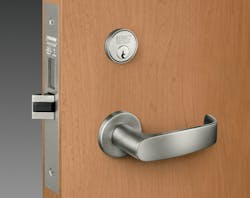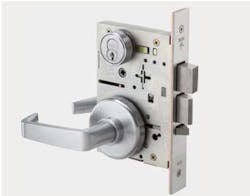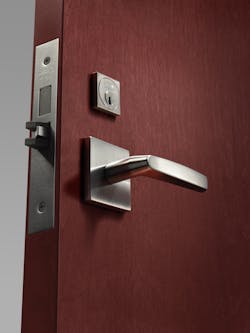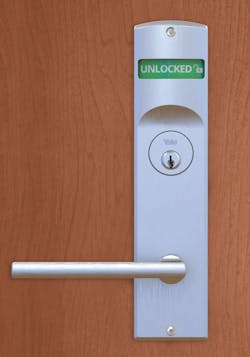Mortise locks have been around for thousands of years, although the modern mortise lock is a product of the industrial era.
Mortise locks, of course, are installed in a door cavity and protected by the exterior and interior faces of the door. When a lock body is surface-mounted on the door, it’s referred to as a rim lock. Although similar in design, mortise locks and rim locks can’t be used interchangeably.
The pin tumbler lock was invented by Linus Yale Jr. in 1865. Now, pin tumbler cylinders are used in key-in-knob cylindrical locks, mortise cylinders and other types of locks. With a few exceptions, the mortise locks locksmiths are involved with are used in commercial applications.
Servicing Mortise Locks
Retrofitting a mortise lock into a wood door is a labor-intensive process, and it typically requires a specially designed router and brace that are operated by a specially trained technician. Retrofitting a mortise lock into a steel door also is difficult, with the added issues of code compliance.
Most brands of mortise locks are available electrified or can be electrified as an upgrade through the use of a kit. An upgraded electrified mortise lock still will fit into the same door prep as a mechanical one.
Before mortise lock sizes were made standard, mortise lock “preps” were unique to each brand of mortise lock, so locks weren’t necessarily interchangeable, even within the same brand. Fortunately, that has changed.
Servicing today’s mortise locks includes performing electronic upgrades, as well as repairing malfunctions. Typically, these would be performed in a controlled environment, such as a cleared workbench.
A cleared workbench is so you can organize the components and screws as you disassemble the mortise lock. A drop cloth is advised to capture any springs or levers that might fly out of the mortise lock body when the cover is removed. A “fixture” of some sort into which you can place the lock to hold it during surgery can be fashioned of plywood and some screws.
When servicing, keep in mind that researching the lock can be helpful, because information about that lock could be available online and make the job easy.
Another tip: Take pictures throughout the process. This can be a big help when it’s time to reassemble the lock.
Servicing Older Locks
Fortunately, thanks to mass production, all newer mortise locks that have the same model number have identical components and use a uniform part-numbering system. You still might encounter older mortise locks of the handmade, one-of-a-kind variety, which are much more difficult to service.
It’s advisable, when possible, to have a working service spare lock on hand, perhaps off an unused door that can be padlocked safely.
If you want to send out the lock for repair or upgrade, companies, such as Securitech or Command Access, might be able to assist you if the original manufacturer has gone out of business.
Because mortise locks are so well made these days, frequently they fail only during a physical attack that involves a breaching tool (crowbar, hammer) or possibly a pickup truck.
Bear in mind that locks don’t work well (if at all) on damaged or poorly adjusted doors. Also, locks don’t work well or last too long if they weren’t installed properly in the first place.
Customers sometimes might be insulted when you tell them that the repair will involve a door repair as well as a lock repair, but the door hardware is only as strong as the door itself. A frequent mistake when quoting a door lock is pricing out the lock but not including the parts and labor necessary to put the door in proper working order. You, too, can be “the fixer.”
Following are some of the mortise locks on the market today.
BEST 45H
The BEST 45H standard mortise lock is aimed at high-traffic applications and features precision-engineered components backed by a limited lifetime mechanical warranty.
If you want to keep your options open, BEST has developed “universal” locks that can be configured to a variety of common functions, all without opening the lock case. When any of the universal functions are ordered as a complete lock, all necessary parts, including trim, are provided to configure functions.
Universal locks can be ordered only with sectional trim. If escutcheon trim is desired, order a three-part lock.
More info: www.bestaccess.com
Schlage L Series
The Schlage L Series can meet the demands of most every application. More than 55 functions, 35 lever and knob designs, eight different roses and escutcheons and a multitude of prep options are available. In addition, 180-degree visibility indicators, advanced motor-driven electrified functions and a universal lock case increase a lock’s capabilities. The L Series can fit with tubular, exit device and multipoint locks to integrate into any environment.
The Schlage LE series is the electronic version of the Schlage L, and it’s designed to extend electronic access control (EAC) deeper into a building beyond traditional perimeter and high-security openings.
LE wireless locks are integrated into popular EAC systems from Allegion access control alliance members.
The LE design packages the mortise lock, credential reader and access control sensors in a small footprint. It features two trim options and a broad range of decorative lever and finish choices.
More info: www.us.allegion.com
Corbin Russwin ML2000 Series
Certain ML2000 functions provide a multifunction lock body that allows you to reconfigure a select group of functions without dissembling the lock case when using only a few additional parts. This multifunction feature enables flexibility and optimizes stocking capability.
Upgrade opportunities include adding status indicators to existing mechanical locks and upgrading trim to decorative hardware or behavioral health.
More info: www.corbinrusswin.com
SARGENT 8200 Series
The 8200 Series mortise lock is designed and constructed with the highest quality components to provide maximum security, performance and durability. The robust lock includes a multitude of lever and escutcheon styles. The electromechanical version can be used in stand-alone applications or as part of an integrated EAC system.
Upgrade opportunities include adding status indicators to existing mechanical locks and upgrading trim to decorative hardware or behavioral health.
More info: www.sargentlock.com
Corbin Russwin/SARGENT SN Series
The SN Series, which is available in mortise, is Grade 1 hardware that provides the highest degree of physical security available in EAC locks.
The SN Series is suited to mixed-credential environments, and it enables easy migration to higher security credentials and mobile access. It supports dual-factor authentication and now features Open Supervised Device Protocol (OSDP) communication.
The SN Series offers continuously monitored end-to-end wiring, which protects against tampering and “man in the middle” attacks.
Corbin Russwin/SARGENT IN120
The IN120 Series, which comes in mortise, supports multiple credential types to leverage existing IT infrastructure and deliver advanced access control to more openings.
The IN120 includes multi-CLASS SE technology, so it enables an easy transition to higher security credentials, including mobile.
When combined with the hands-free functionality of the ALP paddle trim, the IN120 allows for any facility to be upgraded.
More info: www.corbinrusswin.com, www.sargentlock.com
Securitech 5000, 7000 and 8000 series
Securitech multipoint mortise locks provide safety and security in one lockset. Traditional lock operation — key, thumbturn or lever retraction — operates all deadlocks simultaneously.
The 5000 Series is a customizable deadbolt lock that’s operable as a single or multipoint lock. The 5000 Series is available with a variety of bolt configurations and fastens the door to the frame like a bank vault lock. This provides discreet protection with the lock’s deadbolts concealed within the door.
Securitech’s 7000 Series multipoint mortise locks have a wide variety of available functions as well as custom functions to meet almost any demand.
Finally, Securitech’s Auto-Bolt 8000 automatic deadbolt lock-projection locksets are trigger-activated. When the trigger hits the strike, up to three stainless steel deadbolts project into the frame. A single motion retracts all the deadbolts for easy exiting for high-security facilities.
More info: www.securitech.com
Yale 8800 Series
More info: www.yalecommercial.com
Tim O’Leary is an experienced security consultant and a regular contributor to Locksmith Ledger.
10 Reasons to Like Mortise Locks
- They encourage client retention.
- They’re robust and reliable.
- They can accept virtually any keyway.
- They’re serviced and installed by locksmiths.
- They work on storefronts.
- They’re available with deadbolts.
- They can be used with EAC stand-alone keypads.
- They can be used with exit devices.
- They’re single-motion activated to release the deadbolt.
- They can be upgraded to provide remote monitoring and remote unlocking.
Tim O'Leary
Tim O'Leary is a security consultant, trainer and technician who has also been writing articles on all areas of locksmithing & physical security for many years.









